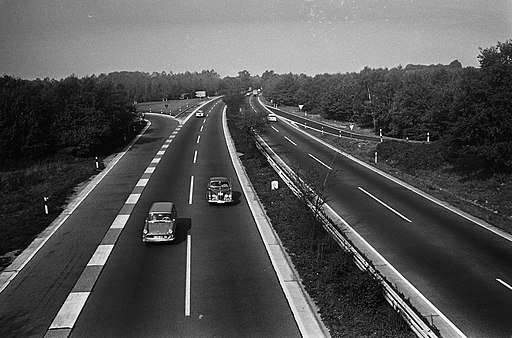The myth of German Autobahn
- 06. August 2019 - General, Germany, Historical Events, Knowledge
Germany and its famous Autobahn (highway) - for almost 100 years it has been part of German infrastructure and is known all around the globe for its lack of speed limits. There are even tourists who visit Germany just for the sake of experiencing this "joy". But when exactly was the first Autobahn opened in Germany?
First things first, it was not Adolf Hitler who had the idea, although that is a common misconception. The first Autobahn-like street was opened in Berlin as early as 1921. It is called AVUS to this day. However, it was a privatized street, which means that you had to pay for its use.
The first public Autobahn, today called A555, was opened on 06 August 1932 by Konrad Adenauer (mayor of Cologne from 1917 to 1933). It connected the cities of Cologne and Bonn. The construction of the four-lane "highway without crossings" only lasted three years - an astonishingly short time. Furthermore, a police law just for this highway was put into place, in which it was determined which vehicles could use the new highway and, of course, which behaviors were forbidden.
Naturally, more plans for future highways were developed at the time, but many of them could not be executed or finished due to the Great Depression. One of these planned, but not finished highways was the Autobahn Cologne-Düsseldorf, which was already secured by law in 1929. The first part of the Autobahn, which was just 2.5 km long, was opened on 23 September 1933 in Opladen and was meant to be some kind of bypass.
Of course, the construction of this highway was reinterpreted by the National Socialist for their own propaganda purposes and the myth of the German Autobahn was born. For example, the highway between Cologne and Bonn was reduced to the status of a country road. This was probably done to be able to claim that they had built the first Autobahn. All in all, the National Socialists built more than 3,000 km of highways in Germany. At the beginning, indeed mainly unemployed people were used to build them. They had to do it by hand and got paid as little as 3 Reichsmark per day. Later on, prisoners of war, concentration camp inmates and especially forced laborers were used to execute the construction of the "Reichsautobahn".
After the Second World War, the highways of the National Socialists were given to the Federal Republic of Germany in 1949. To this day they are the foundation of the highway network in Germany.
By the way, the term "Autobahn" was coined by Robert Otzen in 1927 and derives from the name of the most popular transport means in Germany to this point - the railway (in German: Eisenbahn).


0 comments